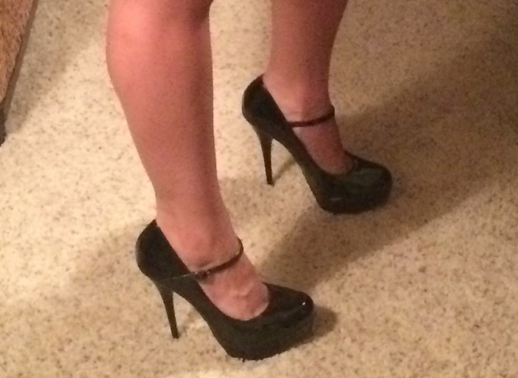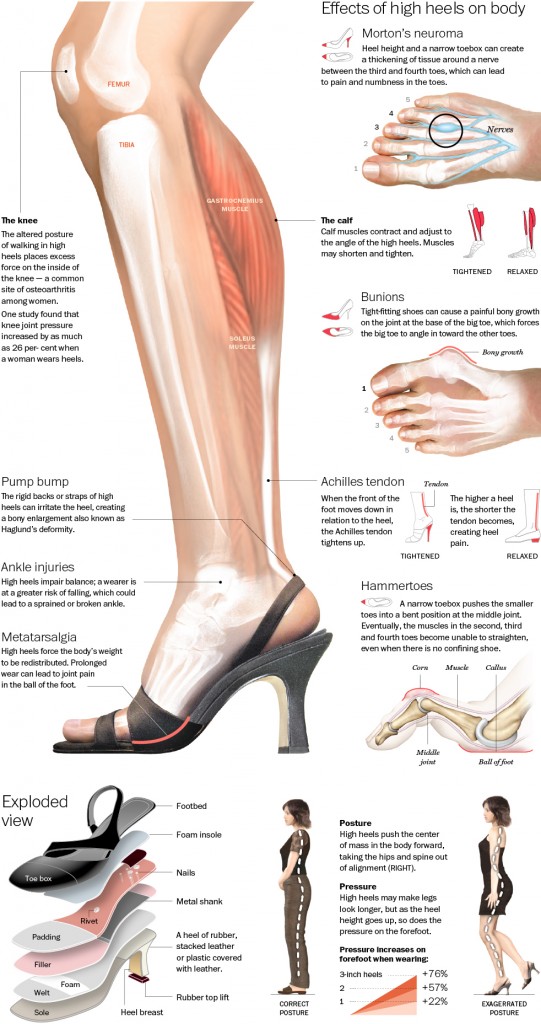A Tale of Two Feet
Written by Teena Travis
So here’s the thing, I love an amazing pair of high heels! They give me a boost of confidence and complete a look like almost nothing else. In fact, I love heels so much that I had one tattooed on my leg. Like most women working in the professional world I found that wearing heels was almost a job requirement. Outside of work I wore them because, well frankly, I wanted my behind and my legs to look good.
One day during a squatting workout, I had a coach ask if I frequently wore high heels. My first reaction was a little visceral, something along the lines of “Who is this guy, and how would he know that?!” I tentatively replied with “Yeah…” It was then that he explained to me that heels were possibly the reason behind my inability to consistently break parallel.
As a result of my heel wearing, I did not have the best calf flexibility. He said that it could potentially be due to my high heel addiction. I politely nodded my head as he proceeded to drop some knowledge bombs on me concerning my calf flexibility and he even cared enough to show me some stretches after class that would help improve that flexibility.
That got me to thinking – How could this coach, who I had never seen before, know that I had a heel addiction? Why were all of the other coaches constantly reminding me to break parallel during the workouts? What was more important to me – my heels or my progression toward become the best possible athlete I could be? I did some research (I’m relatively sure everything I read was exactly what this coach had said to me in class that day) but I guess I just needed to see it for myself.
Did you know that nearly 72% of women wear high heels (YEAH! I’m not alone!) [1]? But did you also know that high heels push your chest and lower back forward taking your hips and spine out of alignment? Your back has a normal S-curve shape that acts as a shock absorber rather effectively, reducing the stress that is placed on your vertebrae. When we wear heels it causes our spine to flatten and then…poof! There goes the effectiveness of those shock absorbers, resulting in good old fashioned back pain [1].
Heels also result in added pressure on your knees, not to mention the pressure that gets put on the balls of your feet through all that downward force in the shoe. When you look at the daily use of high heels over a number of years (and this is totally me here) you end up with actual changes in your anatomy! There is so much undue stress that is put on your back and knees that your body weight actually begins to shift forward. Your calf muscles shorten (Blast! The coach was right!) and your tendons begin to thicken.
Now let’s get into the hard truth of the heel wearing business. Am I really going to give up wearing heels for the rest of my life? The honest answer is probably no. While it worked for me to stop wearing heels in my daily life, that decision is not for everyone. Quite frankly, it isn’t even feasible for every individual. So let’s work on mitigating the damage. A three-inch heel increases the pressure on the ball of your foot by a whooping 76%. If you have to wear heels, maybe consider a shorter heel; just dropping the height to 2 inches will decrease the pressure by 19%.
Try to avoid wearing heels all day, every day. Something as simple as starting a ‘no heel Tuesday’, or ‘no heels after 5pm’ rule can help. Avoid the pointed toe (incidentally my preferred style) and most importantly, stretch before and after you wear high heels. Try coming to class a little early and taking a few minutes to stretch out your calves and mobilize your back and hips. Most importantly remember that it’s all about balance. Some days you’ll just want to wear the heels and that’s ok!
Reference
[1] “How High Heels Affect Your Body.” Spine Health Institute. N.p., n.d. Web. 26 Sept. 2015.


After reading this I had to look up what exactly ‘breaking parallel’ actually means and of course it made sense when I found out it meant to squat with your hip joint below 90 degrees and that in fact when we don’t squat low enough it actually puts strain on our knees (about 28%) but also increases the stress put on our back by over 1000%! Personally squatting is something I have always struggled with and thanks to your informative post I know a possible reason why. The unlikely culprit being high heels, who would of thunk it? Heels are… Read more »
That Coach was me!